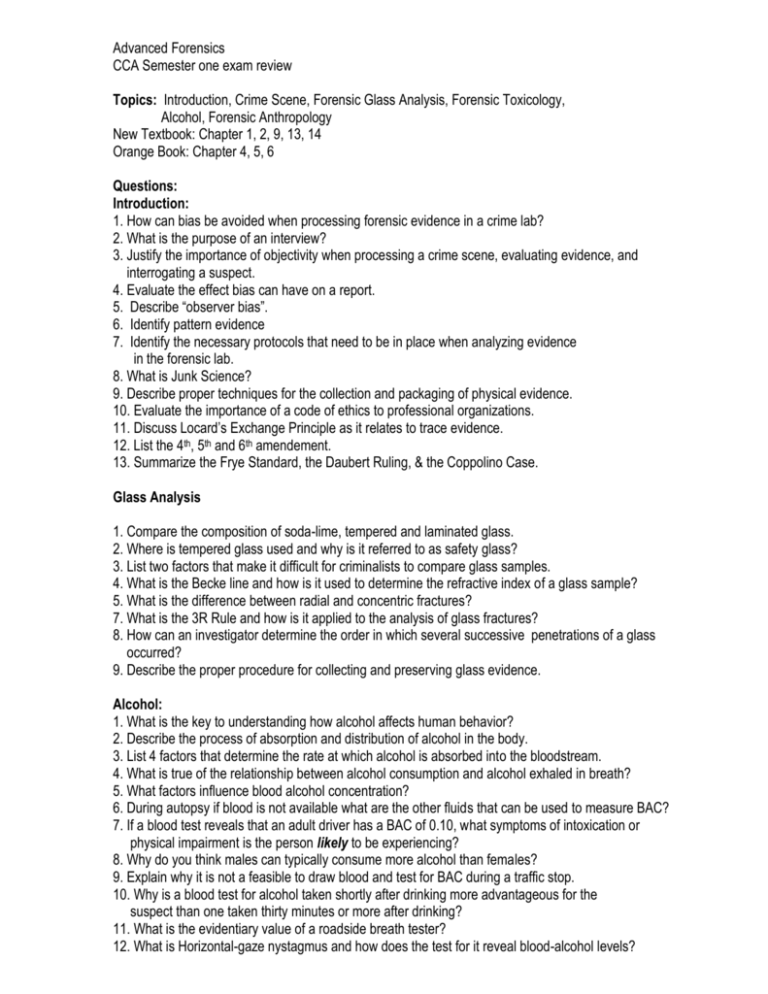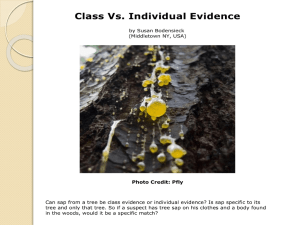File - Ms. Connor's Website
advertisement

Advanced Forensics CCA Semester one exam review Topics: Introduction, Crime Scene, Forensic Glass Analysis, Forensic Toxicology, Alcohol, Forensic Anthropology New Textbook: Chapter 1, 2, 9, 13, 14 Orange Book: Chapter 4, 5, 6 Questions: Introduction: 1. How can bias be avoided when processing forensic evidence in a crime lab? 2. What is the purpose of an interview? 3. Justify the importance of objectivity when processing a crime scene, evaluating evidence, and interrogating a suspect. 4. Evaluate the effect bias can have on a report. 5. Describe “observer bias”. 6. Identify pattern evidence 7. Identify the necessary protocols that need to be in place when analyzing evidence in the forensic lab. 8. What is Junk Science? 9. Describe proper techniques for the collection and packaging of physical evidence. 10. Evaluate the importance of a code of ethics to professional organizations. 11. Discuss Locard’s Exchange Principle as it relates to trace evidence. 12. List the 4th, 5th and 6th amendement. 13. Summarize the Frye Standard, the Daubert Ruling, & the Coppolino Case. Glass Analysis 1. Compare the composition of soda-lime, tempered and laminated glass. 2. Where is tempered glass used and why is it referred to as safety glass? 3. List two factors that make it difficult for criminalists to compare glass samples. 4. What is the Becke line and how is it used to determine the refractive index of a glass sample? 5. What is the difference between radial and concentric fractures? 7. What is the 3R Rule and how is it applied to the analysis of glass fractures? 8. How can an investigator determine the order in which several successive penetrations of a glass occurred? 9. Describe the proper procedure for collecting and preserving glass evidence. Alcohol: 1. What is the key to understanding how alcohol affects human behavior? 2. Describe the process of absorption and distribution of alcohol in the body. 3. List 4 factors that determine the rate at which alcohol is absorbed into the bloodstream. 4. What is true of the relationship between alcohol consumption and alcohol exhaled in breath? 5. What factors influence blood alcohol concentration? 6. During autopsy if blood is not available what are the other fluids that can be used to measure BAC? 7. If a blood test reveals that an adult driver has a BAC of 0.10, what symptoms of intoxication or physical impairment is the person likely to be experiencing? 8. Why do you think males can typically consume more alcohol than females? 9. Explain why it is not a feasible to draw blood and test for BAC during a traffic stop. 10. Why is a blood test for alcohol taken shortly after drinking more advantageous for the suspect than one taken thirty minutes or more after drinking? 11. What is the evidentiary value of a roadside breath tester? 12. What is Horizontal-gaze nystagmus and how does the test for it reveal blood-alcohol levels? 13. What is a divided attention task? Name and describe two divided-attention tasks often administered during field sobriety tests. Toxicology: 1. Why is it important to do a presumptive test before performing a confirmatory test? 2. Explain the statement: “All drugs are poisons” 3. Compare and contrast a stimulant with a depressant. 4. Define toxicology. 5. List the 4 ways that people are exposed to drugs or other toxins. 6. Identify the factors that determine toxicity level of poison. 7. What does it mean when we say a substance is an indirect toxin? 8. Identify the bodily fluid samples that are taken for chemical analysis. 9. What is the job of the forensic toxicologist? 10. Compare and contrast illegal drugs with controlled substances. 11. What is the Maximum Therapeutic Concentration and the Maximum Toxic Concentration level? 12. Compare and contrast psychological and physical dependence. 13. What are anabolic steroids used for? 14. Compare and contrast narcotics and hallucinogens? 15. Describe how a drug gets into the bloodstream when it is injected, snorted, smoked, or swallowed. Forensic Anthropology (Chapter 13) Study notes Read the Chapter Chapter Review





